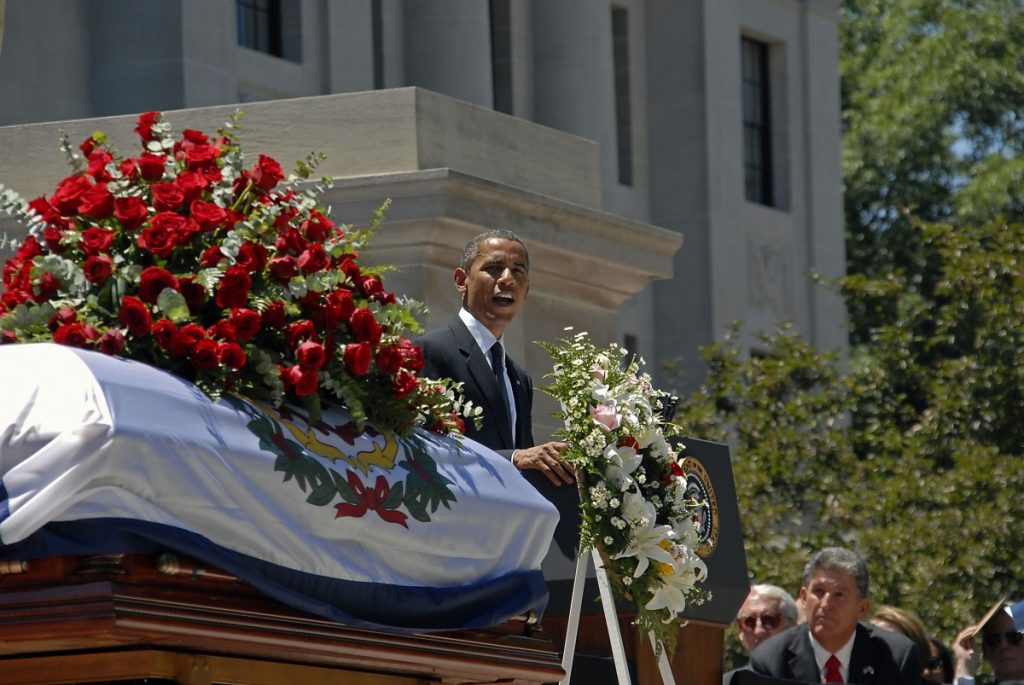Name a significant event in West Virginia over the last three decades. There’s a good chance Steven Rotsch was there.
He was on the scene at two major mine disasters. He was front and center at seven gubernatorial inaugurations. He was there for nearly every major natural disaster. He met U.S. presidents. He met Arnold Schwarzenegger. He attended the funeral of U.S. Senator Robert C. Byrd. He was there for West Virginia’s 150th birthday.
You’d have a difficult time finding Rotsch in footage or photos of these events. He prefers to be on the other side of the lens.
For 25 years, Steve Rotsch worked as the West Virginia Governor’s personal photographer. He chronicled the administrations of five governors of both political parties: Caperton, Wise, Manchin, Tomblin and Justice. He captured photos worthy of history books as well as more intimate moments, from the marble walls of the West Virginia State Capitol to the straw-covered midways of county fairs.
He retired from the job in December 2020, much to his own surprise. Rotsch figured his career would have ended long ago.
For one thing, professional photographers aren’t in demand the way they were in the days of 35 millimeter film and darkrooms.
For another, Rotsch was legally blind for the last dozen years of his career.
Rotsch grew up in a working class family in Staunton, Illinois. His dad worked construction. His grandfather wanted Rotsch to learn to live off the land, so they would eat anything Rotsch would shoot – from squirrels to sparrows and groundhogs to raccoons.
He didn’t start shooting with cameras until college. His uncle was an avid photographer and Rotsch set up a darkroom in his basement.
“He had all the parts, he’d just never put it together,” Rotsch said.

He eventually began writing stories and shooting photos for local newspapers. Rotsch gave up writing when he found it too difficult to take notes and photos at the same time.
“I learned you can’t do both well,” he said. “You get a great story, but there’s no way you’re going to get a picture of it.”
He also became the forensic photographer for the Macoupin County coroner and sheriff offices. But photography was never Rotsch’s full-time job until he got a fateful call from West Virginia.
Eric Newhouse had been the Associated Press’s bureau chief in St. Louis, where Rotsch was freelancing for a rival wire service. Newhouse transferred to run the bureau in Charleston, West Virginia, and needed a reporter and a photographer to cover the West Virginia Legislature. So he called Rotsch and his then-wife Paige, who was working as a reporter at a newspaper in Tennessee.
The couple moved to West Virginia in 1985. Rotsch was the only AP photographer in the state, so whenever and wherever news happened, he got a message on his company-issued beeper.
“I was 24/7. If something happened, I was gone,” he said. “Eighty-five was the year of the flood. There were floods in the south, there were floods in the north. I think I drove 2,000 miles in two weeks.”
He kept a full darkroom kit in the trunk of his car, plus some dark plastic to cover up hotel windows and two days worth of clothes.
Rotsch covered the 1986 riot at the West Virginia State Penitentiary in Moundsville, even heading inside the prison walls to take photos.
“(The warden) opens the door and says, ‘Once you go through this door, you’re on your own,'” Rotsch said.
He was there in 1987 when Manson Family member Lynette “Squeaky” Fromme escaped from the Alderson Federal Prison for Women — only to turn herself in two days later, on Christmas Eve, cold and hungry.

“The problem was, she didn’t realize there was nothing around Alderson,” Rotsch said.
He went to the Church of the Lord Jesus with Signs Following in Jolo, West Virginia, where congregants handle poisonous snakes during worship. The church didn’t allow journalists at the time, and for good reason. Previous stories seemed more interested in gawking at the church than accurately telling its story.
“They were condescending,” Rotsch said.
So Rotsch went to the church every Sunday for three weeks, without his cameras.
“I just talked. I didn’t push,” he said.
On the third weekend, the minister pulled him aside. “Next week,” he told Rotsch, “bring your cameras.”
Rotsch took photos of a worship service and also visited the home of Dewey Chafin, the man who kept snakes for the church.

“While we’re there he said, ‘Be careful, there’s a timber rattler loose,’” Rotsch recalls. “We found it behind the door.”
Rotsch and his wife left West Virginia in 1989 and transferred to the AP’s operations in Traverse City, Michigan. But after a while, his beeper quit beeping.
The Associated Press was devoting more of its money to cover the Middle East as the first Gulf War ramped up.
Rotsch was only a freelancer for the AP. If he wasn’t taking pictures, he wasn’t getting paid.
He pieced together other assignments to make ends meet — selling photos to calendars, magazines and newspapers — until he got another call from Charleston.
This time it was George Manahan. He was a TV reporter when Rotsch met him, but was now press secretary for Governor Gaston Caperton. Caperton was nearing the end of his first term, his photographer left, and Manahan needed someone to fill in. Rotsch agreed to take the job.

“I thought, I’ll work until the re-election of the governor and then I’ll go back to Michigan,” Rotsch said.
Things didn’t go as planned. Rotsch and his wife got divorced. But Caperton won his re-election campaign, so at least he still had a job. Rotsch found he enjoyed the job of governor’s photographer.
“It’s exactly the same as being a news photographer. You’re there to show people what happened,” he said. “You want to be a fly on the wall.”
But unlike a news photographer, Rotsch now had much more behind-the-scenes access.
He was there in the governor’s mansion when Arnold Schwarzenegger stopped by to promote school physical fitness. Rotsch didn’t notice him at first — he thought he was just a guy in a puffy jacket. Then Schwarzenegger removed the jacket and his torso didn’t get any smaller.
“All of a sudden he’s Arnold Schwarzenegger,” he said.

It wasn’t all politicians and celebrities, though. Rotsch found himself photographing lots of regular folks, too, as the governor traveled around the state.
“For a lot of the people … that was the only time they were going to see the governor and I wanted it to be special for them,” he said. “When you meet a governor, it is an important moment.”
In 1996, as Caperton completed his second term and Cecil Underwood prepared to move into the Governor’s Mansion, Rotsch applied to stay on as photographer. But he didn’t get the job. So he went to work for the Clarksburg Exponent Telegram, a small town paper about two hours north of the capital.
“It was a lot of fun. A lot of days I could just take off, drive around and find photos,” Rotsch said. “I could walk into any school, walk into a classroom and I’d ask, ‘What’s going on today?’”
He stayed with the paper for five years but didn’t like the direction the editorial department was taking and resigned. He didn’t tell anyone about his decision. He just planned to move back to Charleston and figure things out from there.
As he was packing up his car, he got another call from the Capitol. It was Governor Bob Wise’s office. They needed a photographer.

“It was absolutely amazing. I’m sitting on the front steps with a box of stuff I’m moving into the car,” Rotsch said. “It was a Friday. And they said ‘When do you want to start?’ I said ‘I’ll be there Monday.’”
The job was largely the same as under the Caperton administration, with one major exception — after a career of using 35 mm film, Rotsch would now make the switch to digital.
This was 2001. Digital cameras were still a little clunky. Rotsch first inherited a Yashika mirrorless camera from Wise’s previous photographer. He noticed there was a significant lag between firing the shutter and when the camera took the photo.
“So if you shot a picture, you might have missed it by half a second,” he said.
After a few months, he convinced the Governor’s Office to buy him a Nikon D1, one of the first digital cameras to get wide use among professional photographers. But the Nikon had its quirks, too.
“It was just horrible,” Rotsch said. “You had this huge battery. One of the batteries I had would take between 7 and 15 pictures. Some took 35.”
He had to carry 6 or 7 batteries to every assignment, a load so heavy his back started to hurt.
Rotsch burned through lots of batteries with Wise. The governor traveled the state constantly after the 2002 debut of the Promise Scholarship, West Virginia’s merit-based tuition program that covered the cost of state schools. First, Rotsch travelled with Wise as he encouraged students to get their grades up to qualify for the program, then to personally congratulate the ones who earned it.
Wise also logged many miles after flooding again destroyed homes and businesses around the state in 2003.

Rotsch said these tours were not just photo ops. By trading his suit and wingtips for jeans and boots, Wise could both comfort his constituents and direct the state’s disaster response.
“A governor has the power to focus help where it’s needed at the moment,” he said. “It wasn’t just a show.”
When voters chose Joe Manchin as West Virginia’s next governor in November 2004, Rotsch didn’t apply to keep his job. He figured Manchin’s team probably had someone in mind. It turns out, they did.
No one from the Manchin administration contacted Rotsch so, the day of the inauguration, he went in early to clean out his office. When he arrived, all of Manchin’s people were already there.
“I said, ‘Oh crap, I’m going to get fired in front of everybody.’”
Just then, Manchin walked out of his office and came up to Rotsch.
“He said, ‘You’re going to stay aren’t you?’”
The Manchin years would prove to be some of Rotsch’s busiest.
In 2006, an explosion at a coal mine in Sago, West Virginia, trapped 13 miners underground. Reporters from around the world descended on the tiny town, congregating with the trapped miners’ families at the Sago Baptist Church.
“I’d never seen that amount of journalists in one place,” Rotsch said.

Rotsch was at Sago when reporters and the families received word that 12 miners had survived and one had died, and rescuers would be bringing them out of the mine soon. He got in his car and headed for home.
But about an hour into his drive, an announcement came over the radio. The initial reports had been incorrect: only one miner had survived. Twelve men were dead. Rotsch turned around in the middle of U.S. 119 and pointed his car back toward Sago.
“When I got there, there were lines of ambulances. They might have been there before, but I didn’t notice them,” he said.
In April 2010, another explosion killed 29 men at the Upper Big Branch mine in Montcoal, West Virginia. Rotsch again went to the scene of the disaster and also photographed the memorial service for the miners, which featured both President Barack Obama and then-Vice President Joe Biden. He photographed Obama and Biden again just a few months later, at the funeral of U.S. Senator Robert C. Byrd.

In addition to these large-scale tragedies, Rotsch’s time with Manchin very nearly ended in personal tragedy, too.
Around 2005, he developed a strange malady. His eyes constantly watered and sometimes would clamp shut and not reopen. This could last for hours. The condition got worse as time went on. He began experiencing constant, excruciating headaches.
It affected his job. When he was at an event with Manchin, he would often bump into the governor if he suddenly stopped to shake someone’s hand.

“He’d say ‘Oh, that’s just my blind photographer.'”
Rotsch learned to take photos without using his cameras’ viewfinder, relying on their autofocus function to capture images.
He went to four ophthalmologists. Each diagnosed him with extreme dry eye. They prescribed him special eye drops. Nothing helped.
“Every doctor told me the same thing, ‘You’re just going to have to learn to live with it,’” he said.
But Rotsch couldn’t live with it. He couldn’t drive. He had trouble feeding himself. He had trouble brushing his teeth. He couldn’t watch TV. And he was suffering alone. He was single at the time and all his family lived in Illinois, so he had no one to help him.

Eventually, his condition became so severe that Rotsch went to Larry Puccio, Manchin’s chief of staff, and told him he was going to turn in his 30-days notice.
“It was hopeless at that point. When I was talking to Larry, I knew I was going to commit suicide. I wasn’t going to live in this pain,” Rotsch said.
Puccio told the governor, who suggested Rotsch make a visit to his personal eye doctor, just a few blocks from the Capitol. Rotsch was skeptical but made an appointment anyway.
“Less than a minute and a half in, he said ‘You have blepharospasms.’ He described exactly what I was experiencing,” Rotsch said. “It was like the heavens opened up.”
Blepharospasms are a rare condition that causes uncontrollable muscle spasms around the eyes. The brain tells the eyes to open and close at the same time, so the muscles are constantly working against one another. It’s incurable but can be treated with regular Botox shots, which temporarily relieve the spasms.
Rotsch’s doctor’s appointment was on a Friday. He received his first Botox shot the following Monday. It took several days for the drug to kick in, but once it did, his headaches faded away and his spasms became easier to deal with.
Although he would now be considered legally blind, despite his 20/20 eyesight, the shots made him rethink retirement and ending his life.
Rotsch stayed on with the Earl Ray Tomblin and Jim Justice administrations through the 2010s, in much the same way he got the job with Manchin.

“I think I just stayed in the office and they didn’t realize they could ask for somebody else,” he said.
In the months leading up to Rotsch’s retirement in December 2020, his wife Carla secretly compiled a binder of cards and letters from his friends as well as notes from four of the five governors he served.
“I like to think it all started during my time in office,” wrote Governor Caperton. “To record the history of five governors is a real legacy to leave.”
Tomblin sent a handwritten card.
“So often you caught some of our best — and worst — sides in the office. Your work will remain an important part of WV history,” he wrote.
Justice’s note came on the official gold-sealed letterhead of the West Virginia Governor.
“Whether they were bright times of triumph or tough times of sorrow, you captured the true emotion of every moment on behalf of our state’s highest office,” he wrote. “I believe I speak for everyone when I say that you will be deeply missed.”
The Justice administration has no plans to fill the vacancy left by Rotsch, instead assigning photo duties to the governor’s videography crew. Rotsch may be both the longest-serving Governor’s photographer and the last one.

“I’m like a blacksmith now,” Rotsch joked. “I retired a photographer. I never in my life thought that would happen, especially after digital came along, I thought I’d have to start writing or filling up gas tanks.”
He has no intention to stop making pictures, though. He recently gave a talk on street photography at West Virginia State University and will host workshops at the Three Rivers Avian Center and Twin Falls Resort and State Park in West Virginia this spring and summer.
He recently invested in a new set of cameras. He says he still has plenty to learn about his art.
“There’s something about capturing one picture that epitomizes the whole event. And very few people can do that. A lot of people take great pictures but capturing that one image, that takes something,” he said.
“I just enjoy photography. It’s just kind of who I am.”
Zack Harold is a freelance writer whose work has appeared in The Guardian (UK), 100 Days in Appalachia, Rolling Stone Country, Lapham’s Quarterly and more. He is also a radio reporter with West Virginia Public Broadcasting’s Inside Appalachia Folkways Project. He previously was managing editor of WV Living and Wonderful West Virginia magazines and worked for the Charleston Daily Mail.



